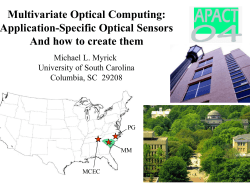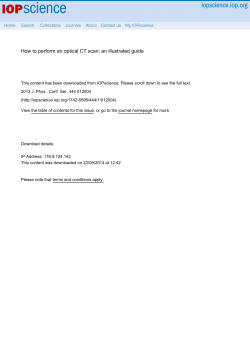
How to build a startup without Venture Capital Serge Bidnyk
How to build a startup without Venture Capital Serge Bidnyk Director of R&D Global Optical Components Market In the late 1990’s, optical components were experiencing incredible growth No sign of any decrease in demand What was expected: (1999) Global Optical Components Market What we actually got… (2003) Telecom Boom & Bust 2001 to 2004 were rather bleak days in optical telecommunications… Massive consolidation happened in the optical components sector Many companies disappeared Many companies merged In retrospect, this may have been a healthy event for the industry… Resulted in: More realistic projections Sustainable, steady growth (versus explosive) But also erosion of optical component pricing requiring new technologies and shift to new markets Now what? The telecom bubble has burst, now what? Historically, startups were funded with Venture Capital money, but… No more IPOs No more acquisitions with unreasonable valuations No more exits for VCs… The number of VC deals plummeted Funding for a telecom startup completely dried out Innovative approach was needed Enablence Background In the last days of year 2003, Enablence was founded by a group of physics Ph.Ds : Matt Pearson, Ashok Balakrishnan, and Serge Bidnyk who also brought in a business person Arvind Chhatbar. Focus: Planar Lightwave Circuits (“optical chips”) mainly for telecom networks Ambition: become a full one-stop-shop for Access, Metro, and Long-Haul products – all PLC Headquartered in Ottawa, Canada Target: Passive Optical Network (PON) ONT Central Office (OLT) Splitter WDM 10-20 km ONT 1x32 ONT Optical Network Terminal (ONT) Optical transceiver at every home: Simultaneously transmits a third channel upstream All multiplexed onto single optical fiber Downstream Transmission Receives two separate wavelengths downstream Upstream 1310 1490 Wavelength (nm) 1550 Incumbent Technology: Micro-Optics Thin-Film Filter technology Automated assembly very difficult Multiple active alignments Multiple levels of packaging Not scaleable Enablence Technology: PLC Components Increased functionality, lower cost High volume chip manufacturing – As many as 1,000 chips per wafer Completely automated assembly No external lenses or filters Scalable to any number of channels Low cost, high reliability Initial funding • • • • • • • • Initial loan of around $100K was provided by an angel investor Founders took no pay for several months but the money was sufficient to kickstart the company After photonics companies were liquidated en masse, Enablence used $70K to purchase essentially all the assets and equipment to build a state-of-the-art laboratory, as well as re-negotiated the lease Talking to Ventures Capitalists was not a priority; however several encounters showed that their investments were suffering and they had no appetite for new deals Other angel investors, most of them from the Oil and Gas industry stepped forward and provided about 2.5 million in investment Enablence moved towards building prototypes of its products The money was used to secure a flip-chip bonder from yet another failed startup – the bonder was used to validate hybrid integration and became the corner stone of Enablence technology Enablence was now on the path to grow its operations and validate its business model Reverse take-over Reverse take-over • • • Shareholders of the private company purchase control of the public shell company and then merge it with the private company The publicly traded corporation is called a "shell" since all that exists of the original company is its organizational structure The private company shareholders receive a substantial majority of the shares of the public company and control of its board of directors Advantages • • • • • The transaction can be accomplished in under 3 months No need to go through the Security regulator review because it has been done by the original company Lesser cost than going through an IPO Less dilution than going through either IPO or VC funding Shares become liquid Reverse take-over – the Enablence way Enablence • • • Identifies Pacific Northwest Partners of Vancouver as a shell company Undertakes reverse take-over of Pacific Northwest Partners in July 2006 During the RTO process raises additional $11.3 million in an over-subscribed round through a private placement deal TSX.V: ENA Enablence becomes a publicly traded company Rapid growth Expansion • • • • • March 2007: Enablence acquires Albis Optoelectronics AG (Switzerland), a manufacturer of photodetectors and photodetector arrays for about $6 million February 2008: Enablence acquires ANDevices (Fremont, California) for $35 million; silicon foundry becomes a part of Enablence April 2008: Enablence acquires Wave7 optics for $12 million and enters the FTTH systems market July 2008: Enablence acquires DuPont’s division for $5 million and obtains access to switching fabric technology November 2008: Enablence acquires Pannaway Technologies and becomes one of the dominant players in FTTH systems market; total number of customers rises to 500 Enablence revenue reaches 60 million a year Enablence 5 years after inception A recognized leader in PLC-based solutions for Access, Metro, and LongHaul networks worldwide Enablence leads in PLC technology innovations, and delivers the infrastructure for next generation telecommunication systems The company’s business is organized in two major divisions: Optical Components & Subsystems Division which provides a variety of products and services based on Planar Lightwave Circuit (PLC) technology FTTx Networks Division which provides Central Office equipment (OLT) and Optical Network Terminals (ONTs) for customer premises 14 Divisions & Locations Enablence Technologies: Headquarters Ottawa, Canada Components & Subsystems Division ð Transceivers Group Ottawa, Canada PLC Subsystems Group Fremont, CA, USA Active Components Group Zurich, Switzerland ð Optical Switching and Routing Group Wilmington, MA, USA FTTx Networks Division Systems Group Atlanta, GA, USA Systems Group Portsmouth, NH, USA 15 FTTx Networks Division FTTH Systems from end-to-end Recognized leader in high-growth FTTH market Market / technology differentiators: Universal PON System GPON, GE-PON, Point-to-Point EMS Management Software Compact OLT solutions, MDU, etc. Over 450 customers worldwide Now the PON solution for Cisco’s “Service Flex” design – Joint marketing for turn-key systems First win with STA Andorra Trident7 Family Indoor ONTs OLT COLT Outdoor ONTs MDU-ONTs Optical Components & Subsystems Division ð Enablence today has product offerings in all levels of the network Optical Networks Long-Haul Linking cities or even continents Metro Communication rings within large cities Access Connecting homes & businesses 18 18 PLC Transceiver Chip for FTTH Highly-integrated component: WDM filter (plus mode converters etc) DFB Laser Monitor photodiode One or more Receiver photodiodes Transimpedance amplifer (TIA) Capacitor Must meet price targets of < $100 (not thousands of dollars) Must be manufactured in volumes of 10k to 200k per month (not per year) Advanced Packaging Technology Making optics more like electronics Low-cost materials and processes (e.g. PCB package) Highly automated production Non-hermetic packaging that uses IC encapsulation technology Frame-level pigtailing and testing PLC is The Future of Photonics Integration, integration, integration… Paths Forward: Advances in PLC technology New platforms for integration & low-cost manufacturing (e.g. SOI?) On-chip integration of optics & electronics? Advanced sub-components designed specifically for use in PLCs Monolithic integration (e.g. InP?) Optoelectronic integration on standard CMOS-SOI PLC-based ROADM Goals Much new R&D still required to reach new targets, new markets Same platforms applied to Biophotonics, Aerospace, Computing, etc. The growth and opportunities in photonics today are more exciting and promising than what was seen during the boom “Today, optics is a niche technology. Tomorrow, it's the mainstream of every chip that we build.” – Patrick Gelsinger, Sr. VP, Intel Corporation Active Components Group Photodiodes and Photodiode Arrays • • • • • High speed photodiodes and arrays Applications in optical interconnects, FTTX, Metro and LH networks Speeds from DC to over 12 Gb/s per channel InP and InGaAs platforms (850 nm, 1310 / 1490 / 1550nm wavelengths) Optimized for integration with PLC platforms and fiber ribbons 23 Transceivers Group Automated Production Highly automated assembly and testing High quality contract manufacturing through Sanmina-SCI Frame-level pigtailing, packaging, and testing Available as Optical Sub-Assemblies (OSAs), or full Transceivers complete with electronics Frame-level assembly & test Optical Sub-Assembly (OSA) 24 Transceiver PLC Subsystems Group Sub-Systems based on PLC technology • Key staff are pioneers of PLC fabrication, several with over 20 years experience • Increased functionality & lower costs compared to traditional optical assemblies • Can integrate 100+ optical functions in a single module Primary circuit functions include: 2. Wavelength filtering 3. Optical switching 4. Splitters & Couplers 5. Optical attenuators 6. Optical monitoring 7. Tunable filters 25 PLC Subsystems Tunable Optical Dispersion Compensation transponders mux amplifiers central office demux transponders central office TODC compensates for pulse broadening; primarily at transponders nodes. Optical Channel Monitor Optical input fiber temperature control circuitry AWG PCB Photodiode Arrays 26 Electrical leads going to Pin-out array PLC Subsystems Hybrid integration: PD to PLC Chip Photodiode Optical waveguide 54.7+0/-10 Hybrid Integration: LD to PLC Chip Laser core Glass Waveguide Solder bump Metal contact pattern 27 Optical Switching & Routing Group • iSelect : Array switch • iDOS: 1xN switch • iOXC: Cross connect switch • iVOA: Variable optical attenuator 28 Optical Switching & Routing Low Cost Serial and/or parallel integration on a chip Telcordia qualified building blocks Short design cycles High Reliability No moving parts No fiber handling Low Power Consumption High thermo-optic coefficient (32 times higher than silica) Extensive Library of Proven Building Blocks 29 Summary There is an alternative to VC funding… … and a reverse take-over is a viable path to grow the company Idea team CPC (shell) + Institutional money Acquisitions and organic growth
© Copyright 2025





















